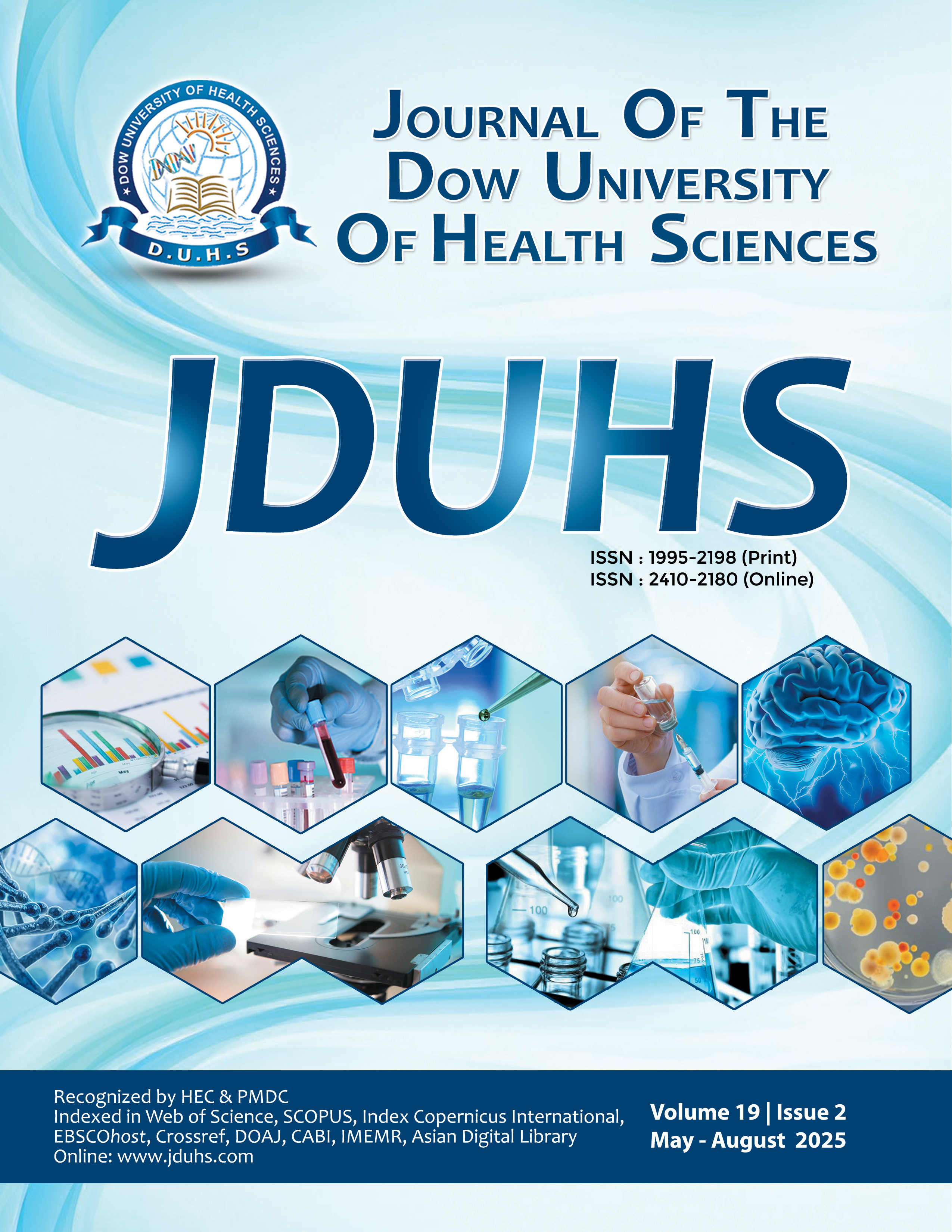Comparison of Outcomes of Classical Lichtenstein and Modified Lichtenstein in Patients with Indirect Inguinal Hernia
DOI:
https://doi.org/10.36570/jduhs.2025.2.2495Abstract
Objective: This study aimed to compare the outcomes of classical Lichtenstein and modified Lichtenstein techniques in patients with indirect inguinal hernia.
Methods: This prospective cross-sectional study was conducted at the Department of Surgery, Ghulam Muhammad Mahar Medical College, from September 2024 to February 2025. Patients aged 18–70 years (American Society of Anesthesiologists class I–III) undergoing surgery for indirect inguinal hernia were included and equally divided into classical and modified Lichtenstein repair groups. Baseline characteristics including age, gender, residence, body mass index, diabetes, hypertension, and smoking status were recorded. Primary outcomes included operative time (minutes), postoperative pain score, surgical site infection, and hospital stay duration (days).
Results: Of the total 68 patients included, the median age was 47.0 years (40.2–54.0). There were 26 (38.2%) males and 42 (61.8%) females. The median duration of the surgical procedure was significantly shorter in the classical group at 38.5 minutes (35.0–41.2) compared to 50.5 minutes (40.7–54.0) in the modified group (p-value <0.001). Postoperative pain scores, assessed using the visual analogue scale, were consistently significantly lower in the modified group across all time points (p-value <0.001). The length of hospital stay was also significantly shorter in the modified group, with a median of 2.0 days (2.0–3.0) compared to 3.0 days (3.0–4.0) in the classical group (p-value =0.016).
Conclusion: Although the classical Lichtenstein technique resulted in a shorter operative duration, the modified technique was associated with significantly lower postoperative pain and a shorter hospital stay, indicating improved recovery outcomes.
Downloads
References
O'Brien J, Sinha S, Turer R. Inguinl hernia repair: a global perspective. ANZ J Surg 2021; 91:2288-95. doi:10.1111/ans.17174.
Hammoud M, Gerken J. Inguinal Hernia. [Updated 2023 Aug 8]. In: StatPearls [Internet]. Treasure Island (FL): StatPearls Publishing; 2025 Jan-. Available from: https://www.ncbi.nlm.nih.gov/books/NBK513332/
Chen J, Glasgow RE. What is the best inguinal hernia repair? Adv Surg 2022; 56:247-58. doi: 10.1016/j.yasu.2022.02.007.
Jain SK, Bhatia S, Hamed T, Khan R, Dua A. A randomised controlled trial of Lichtenstein repair with Desarda repair in the management of inguinal hernias. Ann Med Surg (Lond) 2021; 67:102486. doi:10.1016/j.amsu.2021.102486.
Harjai MM, Nagpal BM, Singh P, Singh Y. A prospective randomized controlled study of lichtenstein's tension free versus modified bassini repair in the management of groin hernias. Med J Armed Forces India 2007; 63:40-3. doi:10.1016/S0377-1237(07)80106-7.
Bulyk I, Shkarban V, Vasyliuk S, Osadets V, Bitska I, Dmytruk O. The history of inguinal hernia surgery. Rozhl Chir 2023; 102:149-53. doi:10.33699/PIS.2023.102.4.149-153
Messias BA, Almeida PL, Ichinose TMS, Mocchetti ÉR, Barbosa CA, Waisberg J, et al. The Lichtenstein technique is being used adequately in inguinal hernia repair: national analysis and review of the surgical technique. Rev Col Bras Cir 2023; 50:e20233655. doi:10.1590/0100-6991e-20233655-en.
Kamani F, Ghorbani H, Mahmoudabadi FD, Chavoshin-ejad M, Hakiminezhad M, Zareifar N, et al. Modified Lichtenstein hernioplasty with concomitant tissue repair: a retrospective study on postoperative chronic pain. BMC Surg 2024; 24:222. doi:10.1186/s12893-024-02513-0.
Ersoz F, Culcu S, Duzkoylu Y, Bektas H, Sari S, Arikan S, et al. The Comparison of Lichtenstein Procedure with and without Mesh-Fixation for Inguinal Hernia Repair. Surg Res Pract 2016; 2016:8041515. doi:10.1155/2016/8041515.
Kumar R, Wani HA, Mahesh A, Mir IN. A prospective comparative study of Lichtenstein procedure with and without mesh-fixation for inguinal hernia repair. Int J Res Med Sci 2021; 9:390. doi:10.18203/2320-6012.ijrms20210412
Holjan S, Hodzic E, Kotjelnikov B. Comparation of clinical outcome of modified Lichtenstein hernioplasty versus classical Lichtenstein hernioplasty. Medical J 2018; 243:78-81.
McCormack K, Scott N, Go P, Ross S, Grant A. Laparoscopic techniques versus open techniques for inguinal hernia repair. Cochrane Database Syst Rev 2003; 1:CD001785. doi:10.1002%2F14651858.CD001785
Bhattacharjee HK, Singla V, Nariampalli Karthyarth M, Parshad R. Persistent scrotal swelling after laparoscopic inguinal hernia repair: "Omentaloma of the scrotum". Asian J Endosc Surg 2021; 14:279-81. doi:10.1111/ases
Zuvela M. The modified Lichtenstein technique for complex inguinal hernia repair--how I do it. Acta Chir Iugosl 2011; 58:15-28. doi:10.2298/aci1101015z
Ahmad T, Khan LA, Khan F, Khan N, Wajid M, Khan I. A comparative study of desarda's technique with Lichtenstein mesh repair in treatment of inguinal hernia. Pak J Med Health Sci 2022; 16:677. doi:10.53350/pjmhs20221612677
Azeem M, Ullha Z, Goraya SU. Prospective randomized study for pain outcome after modified Kugel mesh repair versus Lichtenstein repair. Pak J Med Health Sci 2015; 9:1055-60.
Wajid N, Mahmood S, Ullah MK. Comparative study between outcomes of traditional Lichenstein and sutureless inguinal mesh hernioplasty. Pak J Med Health Sci 2015; 9:205-9.
Ali KA, Ahmad S, Kareemullah M, Ali F, Farooq Q, Karim F, et al. Desarda's repair vs Lichtenstein repair in indirect inguinal hernia-preferred technique. Pakistan J Med Health Sci 2021; 15:3225-6. doi:10.53350/pjmhs2115123225
Pompeu BF, Pasqualotto E, Marcolin P, Delgado LM, Ponte Farias AG, Pigossi BD, et al. Desarda versus Lichtenstein inguinal hernia repair: A meta-analysis of randomized controlled trials. World J Surg 2024; 48:2615-628. doi:10.1002/wjs.12360
Szopinski J, Dabrowiecki S, Pierscinski S, Jackowski M, Jaworski M, Szuflet Z. Desarda versus Lichtenstein technique for primary inguinal hernia treatment: 3-year results of a randomized clinical trial. World J Surg 2012; 36:984-92. doi:10.1007/s00268-012-1508-1
Published
How to Cite
Issue
Section
License
Copyright (c) 2025 Ghulam Fatima komal memon , shahid hussain mirani, sadia saher memon , Dharmoon Arija , Halar Habibullah , Meena Sadaf

This work is licensed under a Creative Commons Attribution-NonCommercial 4.0 International License.
Articles published in the Journal of Dow University of Health Sciences are distributed under the terms of the Creative Commons Attribution Non-Commercial License https://creativecommons.org/ licenses/by-nc/4.0/. This license permits use, distribution and reproduction in any medium; provided the original work is properly cited and initial publication in this journal. ![]()





